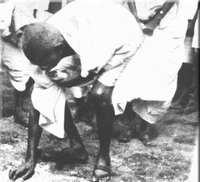 I decided that beyond the larger context of studying the history of India's independence struggle, I would attempt to gain some insight into the life of its most central character - Mohandas K. Gandhi. I approached this goal in a variety of ways. I figured it would be important to let Gandhi tell his own story, so I decided to read his own book - Hind Swaraj or "Indian self rule". In it he defines the principles on which he founded his stratagey of Sattyagraha (non-violent non-cooperation). He explains the tactics he desired for Indians to deploy in their struggle for independence. He also explains how India's independence from Britian was dependent on the Indian people's ability to achieve self-sufficency and break their dependency on Brittish goods and obediance to Brittish laws. I believe that his writing is quite revolutionary for recognition of how Indian's own participation in the system constructed by Brittish rule prevented India's liberation and supported a political and economic systems that kept them enslaved. Reading his own words gave me a kind of insight into him that can not be duplicated by looking at other biographical works.
I decided that beyond the larger context of studying the history of India's independence struggle, I would attempt to gain some insight into the life of its most central character - Mohandas K. Gandhi. I approached this goal in a variety of ways. I figured it would be important to let Gandhi tell his own story, so I decided to read his own book - Hind Swaraj or "Indian self rule". In it he defines the principles on which he founded his stratagey of Sattyagraha (non-violent non-cooperation). He explains the tactics he desired for Indians to deploy in their struggle for independence. He also explains how India's independence from Britian was dependent on the Indian people's ability to achieve self-sufficency and break their dependency on Brittish goods and obediance to Brittish laws. I believe that his writing is quite revolutionary for recognition of how Indian's own participation in the system constructed by Brittish rule prevented India's liberation and supported a political and economic systems that kept them enslaved. Reading his own words gave me a kind of insight into him that can not be duplicated by looking at other biographical works.HISTORICAL SIGHTS
I also visited a number of sights in India that are historically significant to India's independence struggle and to Gandhi's life.
 Gandhi's ashram: where he and his disciples planned their acts of resistance and from where he launched his historic Dandi Yatra or salt march; the event that signaled to many in India that Indians could break their domination by simply refusing to obey the injustices they saw in British laws.
Gandhi's ashram: where he and his disciples planned their acts of resistance and from where he launched his historic Dandi Yatra or salt march; the event that signaled to many in India that Indians could break their domination by simply refusing to obey the injustices they saw in British laws. I visited three Museums in Delhi, Ahmedebad and Mumbai that were dedicated to educating the public about Gandhi's life and works. In these museums I saw . Perhaps the most striking thing was the meager nature of his possession. The fact that someone could weild such power and influence over people, yet have sufficient self-control to limit their material wealth is incredible.
I visited three Museums in Delhi, Ahmedebad and Mumbai that were dedicated to educating the public about Gandhi's life and works. In these museums I saw . Perhaps the most striking thing was the meager nature of his possession. The fact that someone could weild such power and influence over people, yet have sufficient self-control to limit their material wealth is incredible.I also saw a number of sites that were connected to Gandhi's death. I saw the bullet that took his life, and the bloody cloth dodi that was the last article of clothing he wore(he hand-spun it himself of course). I visited a photo exhibit of the ceremonies of national mourning that took place after his death and I went to the site where that ceremony had its culmination and where he was cremated in front the perhaps millions of mourners.
I also visited a department store that was founded by Gandhi's followers and still attempts to adhere to Gandhi's philosophy in the conduct of all of its businiess transactions - a difficult thing to do and still compete in an economic system that favors profit motivated companies. In the process I'm sure I cemented my position in my history department as the resident "Gandhi-ophile"/dork, but having followed him around a bit and seen his belongings, where he lived, and the sights that were significant to the events of his life, I think that I have become more prepared to share his story and reflec on its meaning with my students.
2 comments:
This is our first try. Hopefully, Doc can get pass his "excitement" about computer communication.
Dan Frisby
Post a Comment